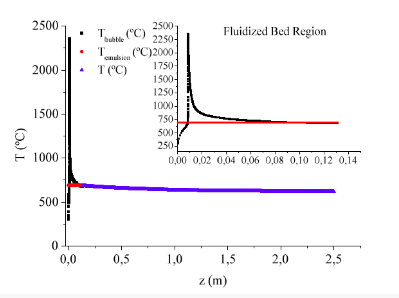Thermo-chemical processes
Biomass
Fluidized bed reactor modelling with application to biomass gasification

One of the main areas of the ISE research group is the FBR modelling with application to biomass gasification. To date, gasification modelling has been mostly focused on coal gasification and previous works have usually taken approaches from literature concerning to coal properties instead of biomass ones. Then, there is a need to do a further step in order to improve the techniques modeling (Kinetic-Fluidization Models, DBMs) and to make better predictive models regarding to the particular biomass properties since biomass gasification has become so popular last years as well as fluidized bed technologies can great advantages at processing fuels.
ISE group modelling efforts are addressed in building predictive tools to save costs and time in the design, the optimization, the operation and the scale-up of FBRs.
Biomass devolatilization kinetics
 Biomass is gaining importance among the world final energy consumption because of its merits of being a renewable energy, widely distributed and carbon neutral. Biomass is also a versatile energy source, which can be used for power generation and to produce liquid biofuels, synthesis gas, chemicals, or charcoal, via thermochemical processes such as combustion, gasification and liquefaction. Biomass pyrolysis takes place during these thermochemical processes. To establish the kinetics of pyrolysis the distributed activation energy model (DAEM) has been proven to obtain accurate results. In this model, three thermogravimetical curves obtained at different heating rates are used to determine the main parameters that describe the devolatilization process, the activation energy and the frequency factor.
Biomass is gaining importance among the world final energy consumption because of its merits of being a renewable energy, widely distributed and carbon neutral. Biomass is also a versatile energy source, which can be used for power generation and to produce liquid biofuels, synthesis gas, chemicals, or charcoal, via thermochemical processes such as combustion, gasification and liquefaction. Biomass pyrolysis takes place during these thermochemical processes. To establish the kinetics of pyrolysis the distributed activation energy model (DAEM) has been proven to obtain accurate results. In this model, three thermogravimetical curves obtained at different heating rates are used to determine the main parameters that describe the devolatilization process, the activation energy and the frequency factor.